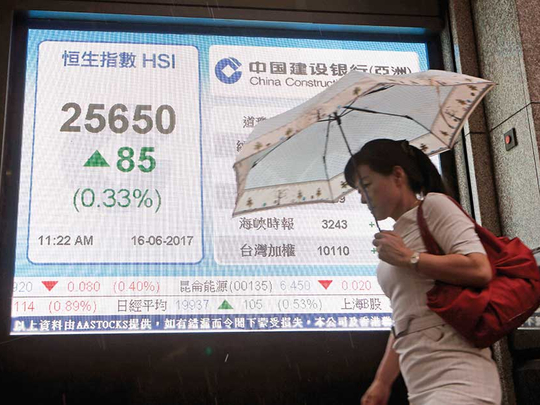
HONG KONG/NEW YORK/LONDON: Hong Kong’s exchange operator is putting the spotlight on one of the murkiest corners of global finance: small-company stock venues.
By proposing sweeping changes to its Growth Enterprise Market on Friday, Hong Kong Exchanges & Clearing Ltd. made a rare acknowledgement that the small-cap market model used in financial centers from New York to London has failed to live up to its promise. While the venues are supposed to match investors with fast-growing businesses too tiny for major exchanges, the reality is that few of the companies make it big and most shareholders suffer losses.
The numbers are sobering. On America’s over-the-counter stock market, one study shows investors lost 27 per cent a year on average in the decade through 2010, versus an annualised return of about 1 per cent for the S&P 500 Index. In Hong Kong, the benchmark GEM index has dropped 90 per cent since its inception in 1999. On London’s AIM exchange, the majority of stocks lose money: greater than 70 per cent had negative returns from the mid-1990s to mid-2015.
“It’s been in a terrible downward spiral,” Low Chee-keong, associate professor at the CUHK Business School and a former member of Hong Kong’s listing committee, said in a phone interview. The Hong Kong exchange “needed to find a way to address this.”
HKEX said its proposals, part of a wider effort to make the city’s markets more competitive, are meant to address concerns about the performance, volatility and liquidity of stocks on GEM. Venues in the UK and the US have defended their existing rules, despite critics who say they’re too lax.
On London Stock Exchange Group PLC’s AIM market, there are no requirements for minimum size or trading history. Each listed firm selects and pays fees to its own primary regulator — a brokerage known as a nominated adviser, or nomad. The system’s potential for conflicts of interest has attracted criticism, while some nomads have faced probes for their roles in market scandals.
“Exchanges do have some responsibility for investor protection,” said Paul Marsh, a professor at the London Business School. “While junior markets like AIM need to be lighter touch, I think the London Stock Exchange has, in a number of ways, been too laissez-faire.”
London Stock Exchange said in a response to queries that people are “wrong to focus on a few incidents that make for a good tale.” The exchange operator said AIM has boosted the UK economy by 25 billion pounds (Dh117.64 billion; $32 billion) and added nearly 750,000 jobs in Britain since it was launched in 1995.
On America’s Pink market, one of three over-the-counter platforms operated by OTC Markets Group Inc., there are no rules for financial standards or public disclosures. Though not regulated as stock exchanges, OTC venues are in many ways the US equivalents of AIM and GEM.
The risks on such platforms came to the fore last August when the market value of Neuromama Ltd., an obscure search engine operator run by an ex-convict, more than quadrupled to $35 billion (Dh129 billion) on tiny volume. The stock was temporarily halted by regulators because of potentially manipulative transactions and concerns about the “identity of the persons in control.” It has since been relegated to the so-called grey market, where companies often struggle to trade.
Despite the potential pitfalls, America’s OTC markets are likely to get a boost from the Jumpstart Our Business Startups Act of 2012, which lets firms raise as much as $1 million via crowdfunding within a 12-month period, something that wasn’t previously allowed. Elio Motors Inc., a three-wheel-car company, became the first to take advantage of the new rules when it listed on an OTC venue last year.
Weak returns
On OTC Markets Group’s website, investors are “strongly advised” to use caution when trading on its Pink market. Its other two venues, OTCQX and OTCQB, have stricter requirements. US small cap markets run by Nasdaq Inc. and Intercontinental Exchange Inc.’s NYSE Group are even more stringent in their standards for listing.
“Our goal is to drive transparency,” Cromwell Coulson, the chief executive officer and president of OTC Markets, said in an interview. He added that the number of companies adhering to higher financial disclosure standards at his venues has increased; 99 per cent of trading in OTC Markets-quoted securities comes from companies with current financial disclosure, Coulson said.
In Hong Kong, returns from the S&P/HKEX GEM Index have trailed the city’s benchmark Hang Seng Index by more than 290 percentage points since 2000. The bourse operator’s revamp plans include higher minimum market-value requirements and tighter rules on when controlling shareholders can sell their stakes. HKEX also wants to create a third venue that would only allow individual investors to buy shares of so-called new economy companies that meet higher regulatory standards.
Finding Gems
Of course, not all investors come to these markets looking for long-term investments. For many, the trading opportunities created by volatility in smaller stocks are the big draw.
On London’s AIM, 39 firms gained more than 1,000 per cent in the two decades through mid-2015, according to data compiled by Marsh and his colleague Elroy Dimson. Marsh added that AIM’s market-wide performance could be turning a corner, pointing to the benchmark index’s gain of more than 30 per cent over the past 18 months.
“We have to sift through the rubble of these companies, many of which we wouldn’t touch, but there are a few gems we hope to uncover,” said Salim Hart, who co-manages the $38 billion Fidelity Low-Priced Stock Fund.
Still, most companies on small-cap platforms never make it to larger exchanges. The graduation rate from AIM to London’s main market is about 6 per cent, according to Marsh and Dimson, though tax considerations play a role. Fewer than 1 per cent of securities quoted on an OTC Markets venue moved to a national US stock exchange in 2015 while in Hong Kong, the rate of GEM transfers dropped to 2.7 per cent last year from 7.2 per cent in the second half of 2008.
HKEX is hoping last week’s proposals will help the venue turn a corner.
The changes will “address recent concerns about the quality and performance of some GEM applicants and listed issuers,” David Graham, HKEX’s chief regulatory officer, said in a statement. “We envision GEM continuing to have an important role in our market as a capital raising platform for small- to mid-sized companies.”
— Bloomberg












